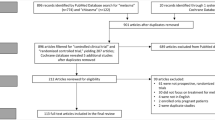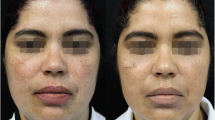Abstract
This study aimed to evaluate the effectiveness of isolated treatment with retinoic acid and its combination with the microneedling technique in facial melasma, seeking to associate these results with possible oxidative damage. This is a blinded randomized clinical trial with 42 women with facial melasma (skin phototype I–IV), randomized into Group A (microneedling and 5% retinoic acid) or Group B (5% retinoic acid alone). Four procedures were applied with 15 days intervals (4 blood collections). Clinical improvement was assessed using the Melasma Area Severity Index (MASI). Serum oxidative stress levels were evaluated by protein oxidation (carbonyl), lipid peroxidation (TBARS) and sulfhydryl groups, as well as enzyme activities of superoxide dismutase (SOD) and catalase (CAT). The statistical analyzes were performed by generalized estimation equation (GEE). There was a reduction in MASI scale and TBARS levels in both groups over time (p < 0.05), with no difference between groups (p = 0.416). There was also a substantial increase in the carbonyl levels at 30 days (p = 0.002). The SOD activity decreased after 30 days, regardless of group (p < 0.001), which was maintained after 60 days. In Group A, there was a reduction in sulfhydryl levels at 60 days (p < 0.001). It is important to highlight that both groups demonstrated efficacy in the clinical improvement of melasma within at least 60 days, reducing the MASI score by almost 50%. However, microneedling with retinoic acid seems to be the worst treatment because there is a reduction in the non-enzymatic antioxidant defense, which is important to protect against oxidative stress.




Similar content being viewed by others
References
Pandya AG, Guevara IL (2000) Disorders of hyperpigmentation. Dermatol Clin 18:91–98. https://doi.org/10.1016/S0733-8635(05)70150-9
Lutfi RJ, Fridmanis M, Misiunas AL, Pafume O, Gonzalez EA, Villemur JA, Mazzini MA, Niepomniszcze H (1985) Association of melasma with thyroid autoimmunity and other thyroidal abnormalities and their relationship to the origin of melasma. J Clin Endocrinol Metab 61:28–31. https://doi.org/10.1210/jcem-61-1-28
Pandya AG, Hynan LS, Bhore R, Riley FC, Guevara IL, Grimes P, Nordlund JJ, Rendon M, Taylor S, Gottschalk RW, Agim NG, Ortonne JP (2011) Reliability assessment and validation of the Melasma Area and Severity Index (MASI) and a new modified MASI scoring method. J Am Acad Dermatol 64:78–83. https://doi.org/10.1016/j.jaad.2009.10.051
Rendon M, Berneburg M, Arellano I, Picardo M (2006) Treatment of melasma. J Am Acad Dermatol 54:272–281. https://doi.org/10.1016/j.jaad.2005.12.039
Tasaka K, Kamei C, Nakano S, Takeuchi Y, Yamato M (1998) Effects of certain resorcinol derivatives on the tyrosinase activity and the growth of melanoma cells. Methods Find Exp Clin Pharmacol 20:99–110. https://doi.org/10.1358/mf.1998.20.2.485637
Chang TS (2009) An updated review of tyrosinase inhibitors. Int J Mol Sci 10:2440–2475. https://doi.org/10.3390/ijms10062440
Ebanks JP, Wickett RR, Boissy RE (2009) Mechanisms regulating skin pigmentation: the rise and fall of complexion coloration. Int J Mol Sci 10:4066–4087. https://doi.org/10.3390/ijms10094066
Oliveira NSMO (2011) Avaliação da atividade antioxidante e efeito sobre a melanogênese de extratos das folhas de Passiflora nitida Kunth. [Dissertação de Mestrado] - Programa de Pós Graduação em Ciências Farmacêuticas. Universidade Federal do Amazonas, Manaus, AM. https://tede.ufam.edu.br/handle/tede/4865
Costin GE, Hearing VJ (2007) Human skin pigmentation: melanocytes modulate skin color in response to stress. FASEB J 21:976–994. https://doi.org/10.1096/fj.06-6649rev
Scheuplein RJ (1976) Permeability of the skin: a review of major concepts and some new developments. J Invest Dermatol 67:672–676. https://doi.org/10.1111/1523-1747.ep12544513
Naik A, Kalia YN, Guy RH (2000) Transdermal drug delivery: overcoming the skin’s barrier function. Pharm Sci Technol Today 3:318–326. https://doi.org/10.1016/s1461-5347(00)00295-9
Park JH, Allen MG, Prausnitz MR (2005) Biodegradable Polymer microneedles: fabrication, mechanics and transdermal drug delivery. J Control Release 104:51–66. https://doi.org/10.1016/j.jconrel.2005.02.002
Kim S, Yang H, Kim M, Baek JH, Kim SJ, An SM, Koh JS, Seo R, Jung H (2016) 4-n-butylresorcinol dissolving microneedle patch for skin depigmentation: a randomized, double-blind, placebo-controlled trial. J Cosmet Dermatol 15:16–23. https://doi.org/10.1111/jocd.12178
Bagatin E, Hassun K, Talarico S (2009) Revisão sistemática sobre peelings químicos. Surg Cosmet Dermatol 1:37–46. https://www.surgicalcosmetic.org.br/detalhe-artigo/10/Revisao-sistematica-sobre-peelings
Steiner D, Feola C, Bialeski N, Silva FAM, Antiori ACP, Addor FAS, Folino BB (2009) Estudo de avaliação da eficácia do ácido tranexâmico tópico einjetávelnotratamentodomelasma.Surg Cosmet Dermatol 1:174–7. https://www.surgicalcosmetic.org.br/detalhe-artigo/39/Estudo-de-avaliacao-da-eficacia-do-acido-tranexamico-topico-e-injetavel-no-tratamento-do-melasma
Lima EA, Lima MA, Araújo CEC, Nakasawa YMM, Leal NC (2018) Investigação sobre o uso do ácido retinoico a 3% e a 5% em soluções para peeling como agente para drug delivery após indução percutânea de colágeno com agulhas (IPCA®): perfil de segurança e protocolo de uso. Surg Cosmet Dermatol 10:22–27. https://doi.org/10.5935/scd1984-8773.201810104
Seçkin HY, Kalkan G, Bas Y, Akbas A, Onder Y, Ozyurt H, Sahin M (2014) Oxidative stress status in patients with melasma. Cutan Ocul Toxicol 33:212–217. https://doi.org/10.3109/15569527.2013.834496
Ma YS, Wu SB, Lee WY, Cheng JS, Wei YH (2009) Response to the increase of oxidative stress and mutation of mitochondrial DNA in aging. Biochim Biophys Acta 1790:1021–1029. https://doi.org/10.1016/j.bbagen.2009.04.012
Kimbrough-Green CK, Griffiths CE, Finkel LJ, Hamilton TA, Bulengo-Ransby SM, Ellis CN, Voorhees JJ (1994) Topical retinoic acid (tretinoin) for melasma in black patients: a vehicle-controlled clinical trial. Arch Dermatol 130:727–733. https://doi.org/10.1001/archderm.1994.01690060057005
Cucé LC, Bertino MC, Scattone L, Birkenhauer MC (2001) Tretinoin peeling. Dermatol Surg 27:12–14
Wills ED (1966) Mechanism of lipid peroxide formation in animal tissues. Biochem J 99:667–676. https://doi.org/10.1042/bj0990667
Levine RL, Garland D, Oliver CN, Amici A, Climent I, Lenz AG, Ahn BW, Shaltiel S, Stadtman ER (1990) Determination of carbonyl content in oxidatively modified proteins. Methods Enzimol 186:464–478. https://doi.org/10.1016/0076-6879(90)86141-H
Aksenov MY, Markesbery WR (2001) Changes in thiol content and expression of glutathione redox system genes in the hippocampus and cerebellum in Alzheimer’s disease. Neurosci Lett 302:141–145. https://doi.org/10.1016/S0304-3940(01)01636-6
Bannister JV, Calabrese L (1987) Assays for superoxide dismutase. Methods Biochem Anal 32:279–312
Aebi H (1984) Catalase in vitro. In: Packer L (ed) Methods in enzymology. Academic Press, Cambridge, pp 121–126
Autenrieth W, Mink F (1915) Ueber lolorimetrische bestimmungsmethoden: die quantitative bestimmung von Harneiweiss. Muenchener Medizinische Wochenschrift 62:1417–1421
Xu Y, Ma R, Juliandri J, Wang X, Xu B, Wang D, Lu Y, Zhou B, Luo D (2017) Efficacy of functional microarray of microneedles combined with topical tranexamic acid for melasma: a randomized, self-controlled, split-face study. Medicine 96:e6897. https://doi.org/10.1097/MD.0000000000006897
Magalhães GM, Borges MDFM, Queiroz ARDC, Capp AA, Pedrosa SV, Diniz MDS (2011) Estudo duplo-cego e randomizado do peeling de ácido retinóico a 5–10% no tratamento do melasma: avaliação clínica e impacto na qualidade de vida. Surg Cosmet Dermatol 3:17–22. https://www.surgicalcosmetic.org.br/detalhe-artigo/109/Estudo-duplo-cego-e-randomizado-do-peeling-de-acido-retinoico-a-5--e-10--no-tratamento-do-melasma--avaliacao-clinica-e-impacto-na-qualidade-de-vida
Ghersetich I, Troiano M, Brazzini B, Arunachalam M, Lotti T (2010) Melasma: treatment with 10% tretinoin peeling mask (2010). J Cosmet Dermatol 9(2):117–121. https://doi.org/10.1111/j.1473-2165.2010.00488.x
Griffiths CE, Finkel LJ, Ditre CM, Hamilton TA, Ellis CN, Voorhees JJ (1993) Topical tretinoin (retinoic acid) improves melasma. A vehicle-controlled, clinical trial. Br J Dermatol 129:415–421. https://doi.org/10.1111/j.1365-2133.1993.tb03169.x
Kimbrough-Green CK, Griffiths CE, Finkel LJ, Hamilton TA, Bulengo-Ransby SM, Ellis CN et al (1994) Topical retinoic acid (tretinoin) for melasma in black patients. Arch Dermatol 130:727–733. https://doi.org/10.1001/archderm.1994.01690060057005
Fabbrocini G, De Vita V, Fardella N, Pastore F, Annunziata MC, Mauriello MC, Monfrecola A, Cameli N (2011) Skin needling to enhance depigmenting serum penetration in the treatment of melasma. Plast Surg Int 2011:158241. https://doi.org/10.1155/2011/158241
Lima EVA, Lima MMDA, Paixão MP, Miot HA (2017) Assessment of the effects of slin microneedling as adjuvante therapy for facial melasma: a pilot study. BMC Dermatol 17:14–20. https://doi.org/10.1186/s12895-017-0066-5
Choubey V, Sarkar R, Garg V, Kaushik S, Ghunawat S, Sonthalia S (2017) Role of oxidative stress in melasma: a prospective study on serum and blood markers of oxidative stress in melasma patients. Int J Dermatol 56:939–943. https://doi.org/10.1111/ijd.13695
Acknowledgements
This work was supported by research grants from Conselho Nacional de Desenvolvimento Científico e Tecnológico (CNPq), Fundação de Amparo à Pesquisa do Rio Grande do Sul (FAPERGS), Coordenação de Aperfeiçoamento de Pessoal de Nível Superior (CAPES) and Centro Universitário Metodista – IPA.
Author information
Authors and Affiliations
Corresponding author
Additional information
Publisher's Note
Springer Nature remains neutral with regard to jurisdictional claims in published maps and institutional affiliations.
Rights and permissions
About this article
Cite this article
Bergmann, C.L.M.d., Pochmann, D., Bergmann, J. et al. The use of retinoic acid in association with microneedling in the treatment of epidermal melasma: efficacy and oxidative stress parameters. Arch Dermatol Res 313, 695–704 (2021). https://doi.org/10.1007/s00403-020-02140-8
Received:
Revised:
Accepted:
Published:
Issue Date:
DOI: https://doi.org/10.1007/s00403-020-02140-8




